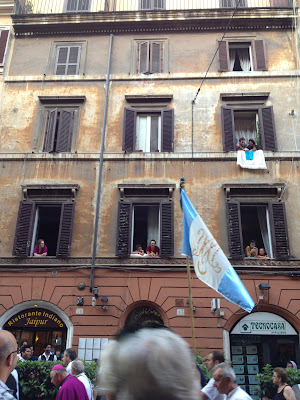 |
| Roscioli bakery, all decked up for Christmas and ready to make some deliveries. Photo by author. |
It's almost Christmas and here in Italy that means one thing: time to stock up on panettone, pan d'oro, torrone, and all the other ubiquitous holiday sweets. And it isn't hard: everywhere you turn, from supermarkets to bakeries to pastry shops, stacks and stacks of these traditional Christmas desserts are just waiting to be snapped up by hungry, sweet-toothed shoppers. Some are becoming so famous that you can find them not just in Italy but around the world.
Here's a guide to Italian Christmas treats.
Panettone
 |
| A baker at Roscioli taking freshly-baked panettoni out of the oven to cool. Photo by author. |
The most famous of the bunch, panettone (which translates roughly to "little big bread") originally comes from Milan. It has a dry cakey consistency and is dotted (unfortunately) with raisins and other bits of candied fruit. Despite being the most commonly found and supposedly popular Italian Christmas treat, I've never actually met someone who likes it (although the mini-version is undeniably adorable). These days, you can find versions without raisins, or better yet, with chocolate chips instead, and this is a vast improvement.
 |
| [Source] |
Pan d'Oro
| [Source] |
Torrone
 |
| [Source] |
Of the "big three," torrone is definitely my favorite. It is not a cake, but a candy, and it hails from the northern city of Cremona, where it was supposedly named after the famous medieval tower of that city (torrone means "big tower.") It's a long, rectangular candy bar made of egg whites, honey, sugar, and various kinds of nuts. Depending on the variety, it can be rock-hard or chewy and sticky. My personal favorites are the ones made with almonds and pistachios, and coated with chocolate. This chocolate coating is not strictly traditional, but the way I see it, when was the last time a dessert suffered from being coated in chocolate? Never, amirite?? They also sell torroni made entirely of chocolate and nuts, but as much as I enjoyed eating them, you can't really call them torroni.
Panforte
 |
| [Source] |
Now, if torrone and panettone got together late one night after closing time in the bakery window and reproduced, the result would be panforte, although in this case I don't think that coupling was wise. This "strong bread" from Siena is the closest thing to a true fruitcake that you can find in Italy, and the best part about it is that it's relatively small. Because, honestly, does anyone actually like fruitcake? Chewy, nutty panforte's only saving grace is that it is spicy (it used be called panpepato, "peppered bread").
Ricciarelli
 |
| [Source] |
Now we're getting to the good stuff. Ricciarelli, named after the famous opera singer Katia Ricciarelli (not really), are little lozenge-shaped cookies that date back to 14th-century Siena. Like all the best Italian cookies, their main ingredient is almond paste and they are covered with powdered sugar. They are simple, delicate, and delicious, and like a good Italian transplant, I happily had several this morning for breakfast.
Cartellate
 |
| [Source] |
From the southern regions of Puglia and Basilicata come cartellate. These seriously sinful sweets are made from cooked wine, cinnamon, honey, and sugar, and deep-fried to a golden brown. I have never tried these southern Christmas treats, but after reading about them (and how to make them) on Ciao Chow Linda's blog, I'm tempted to brave the mad two-shopping-days-left city just to try and find some!
Buccellato
 |
| [Source] |
This wouldn't be an Italian dessert round-up without a nod from Sicily, island that, quite frankly, I wouldn't be surprised to discover was made entirely of sugar. Their signature Christmas treat is buccellato, a ring-shaped cake made of pasta frolla (a light and exquisite pastry dough) and filled with dried figs, orange peel, and chocolate chips. A second version is filled instead with almond paste and dried pumpkin.
Struffoli
 |
| [Source] |
And with that, dearest bloglings, I leave you with your mouths watering while I rush out to do my Christmas shopping (procrastinate much?). Which of these treats is your favorite, and did I leave anything out?















